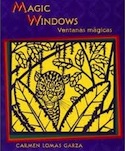By Carmen M. Martínez-Roldán, Teachers College, New York
 Reading Time: Magic Windows/Ventanas Mágicas (1999) by Carmen Lomas Garza
Reading Time: Magic Windows/Ventanas Mágicas (1999) by Carmen Lomas Garza
In this entry I share a vignette of a bilingual pre-service teacher’s and a second-grade bilingual student’s engagement with Garza’s book Magic Windows/Ventanas Mágicas during a read aloud in an after-school program. During reading time, some teacher candidates, such as Diana, observed that when the books they had chosen for the children seemed too long, it helped facilitate the discussion of the book and the entire reading event, in general, when the teacher candidate and the child took turns reading, thus distributing the role of reading between the two. Therefore, Diana and César took turns, each reading a page and making comments. Magic Windows/Ventanas Mágicas is organized in short scenes that can be discussed individually, so Diana and César each chose and read different sections of the book and discussed those sections, commenting on and elaborating upon the information provided, as the following excerpt illustrates (the reading of the picturebook appears within quotation marks). In this reading, it caught my attention the inquiry stance the child adopted and how the text and the pre-service teacher supported that stance. Diana and César had started reading aloud from the book, taking turns, and making comments, both of them posing and asking questions. Now, César is reading in English:
César: Thorns [keeps reading.] “Actually they are not tall . . .over their body to protect themselves . . . . Chameleon . . . Their habitat has been destroyed by humans and so today they are in danger. . .”
Diana: Hmm. Have you ever seen one?
César: In the picture.
Diana: In the pictures? [Laughs.] But not up close, right?
César: No.
Diana: They usually live in the dessert.
César: Can we make a video out of it?
Diana: Okay! We can look those up. Yeah, That’s a good idea.
César: Don’t they have like a lot of spines?
Diana: Uhum…yes, like these.
César: Like the barbed wire?
Diana: Kind of.
César: I got caught by one of those one time.
Diana: You did? By one of these? Was it in your backyard?
[Talk about barbed wire.]
Diana: And we use fences to protect our houses, right? That’s how they [chameleons] use their spines, they use them for—
César: No, they are like … [inaudible]
Diana: Oh! Okay!
[They keep alternating reading the sections, both contributing comments and information about the pictures. César asks questions and makes connections to personal experiences, and Diana poses follow-up questions.]
César: An eagle eating a snake…isn’t that [the] symbol for Mexico[’s] flag?
Diana: Yes, it is.
César: Yeah, it’s green, white, and red.
[They continue talking about his learning of the Mexican flag, reading, and discussing the text. César shares information he knows about the pythons.]
(Excerpts from session on 11/17/2010.)
This excerpt shows the distribution of roles during reading time between the pre-service teacher and the bilingual child, still learning to read. Salient aspects of these roles include Diana choosing Latino literature after taking into account César’s interests in informational books.. Both Diana and César contributed information during the reading (e.g., Diana about chameleons’ use of spines and César about the Mexican flag and pythons). They also both asked questions. Diana assessed César’s knowledge and understanding to adjust the amount of information she was giving and also to follow up on the child’s connections to personal experiences, asking him to extend his descriptions of those experiences. César asked questions seeking information to confirm his hypotheses and knowledge. For example, “Don’t they have lots of spines?” Finally, César wondered if he could create a video about snakes (he was learning to use Animoto to make short videos). In collaboration with the pre-service teacher, César searched for information about snakes in the internet extending his knowledge of the topic Garza had introduced in the picturebook. The creation of a 60 seconds video extended the read aloud and culminated with the production of a multimodal text on snakes and all of this from the read aloud of a picturebook about papel picado (cut-paper art)!
Have you used books that engaged children in inquiry, in desiring to learn more about the topic of the book and of extending the reading with inquiry?
Journey through Worlds of Words during our open reading hours: Monday-Friday, 9 a.m. to 5 p.m. and Saturday, 9 a.m. to 1 p.m. To view our complete offerings of WOW Currents, please visit archival stream.
- Themes: Carmen M. Martínez-Roldán, Magic Windows
- Descriptors: Books & Resources, Student Connections, WOW Currents
